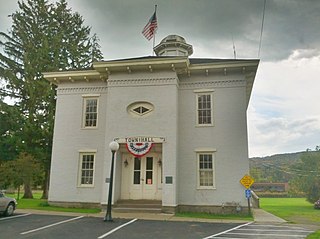
Allegany County is a county in the U.S. state of New York. As of the 2020 census, the population was 46,456. Its county seat is Belmont. Its name derives from a Lenape word, applied by European-American settlers of Western New York State to a trail that followed the Allegheny River; they also named the county after this. The county is part of the Western New York region of the state.
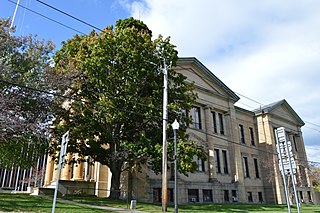
Chautauqua County is the westernmost county in the U.S. state of New York. As of the 2020 census, the population was 127,657. Its county seat is Mayville, and its largest city is Jamestown. Its name is believed to be the lone surviving remnant of the Erie language, a tongue lost in the 17th century Beaver Wars; its meaning is unknown and a subject of speculation. The county was created in 1808 and organized in 1811. The county is part of the Western New York region of the state.

Greene County is a county located in the U.S. state of New York. As of the 2020 census, the population was 47,931. Its county seat is Catskill. The county's name is in honor of the American Revolutionary War general Nathanael Greene. The county is part of the Capital District region of the state.

Orleans County is a county in the western part of the U.S. state of New York. As of the 2020 census, the population was 40,343. The county seat is Albion. The county received its name at the insistence of Nehemiah Ingersoll though historians are unsure how the name was selected. The two competing theories are that it was named to honor the French Royal House of Orleans or that it was to honor Andrew Jackson's victory in New Orleans. The county is part of the Finger Lakes region of the state.
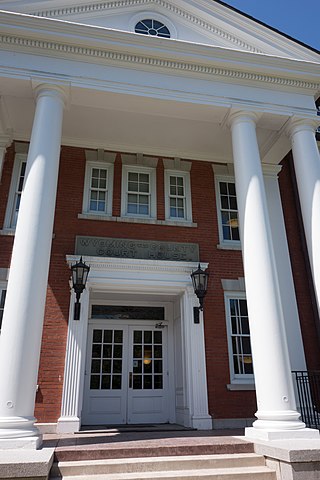
Wyoming County is a county in the U.S. state of New York in the state's western area. As of the 2020 census, the population was 40,531. The county seat is Warsaw. The name is modified from a Lenape (Delaware) Native American word meaning "broad bottom lands". Wyoming County was formed from Genesee County in 1841. Wyoming County is one of New York's mostly agricultural counties. With an estimated 47,500 dairy cows in the county, there are more cattle in Wyoming County than people. The county is part of the Finger Lakes region of the state.

Yates County is a county in the U.S. state of New York. As of the 2020 Census, the population was 24,774, making it the third-least populous county in New York. The county seat is Penn Yan. The name is in honor of Joseph C. Yates, who as Governor of New York signed the act establishing the county. The county is part of the Finger Lakes region of the state.

Bethany is a town in Genesee County, New York, United States. The population was 1,765 at the 2010 census. The town lies on the southern border of Genesee County. US Route 20 and NYS Route 63 pass through the town.

Corfu is a village in Genesee County, New York, United States. The population was 709 at the 2010 census. It is named after the Greek island of Corfu.

Darien is a town in Genesee County, New York, United States. The population was 3,158 at the 2010 census. Darien lies in the southwestern part of Genesee County, southwest of Batavia.

Pembroke is a town in Genesee County, Western New York, United States. The population was 4,292 at the 2010 census. The town is named after a town in west Wales. Pembroke lies on the west border of Genesee County, west of Batavia.

Stafford is a town in Genesee County, New York, United States. The population was 2,459 at the 2010 census. The town was named after a town of the same name in England.

Rush is a town in Monroe County, New York, United States. The population was 3,478 at the 2010 census.

Attica is a town in Wyoming County, New York, United States. The population was 7,702 as of 2010.

Alexander is a village in Genesee County, New York, United States. The population was 509 at the 2010 census. The village is named after early settler, Alexander Rea.

Alexander is a town in Genesee County, New York, United States. The population was 2,491 at the 2020 census. The town is named after Alexander Rea, an early settler, and is on the southern border of the county. It includes a village also named Alexander.

Batavia is a town in Genesee County, New York, United States. The population was 6,293 at the 2020 census. The name is derived from the Roman name for part of the Netherlands.
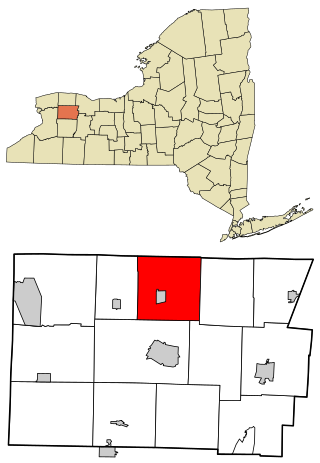
Elba is a town in Genesee County, New York, United States. The population was 2,370 at the 2010 census. The town is at the northern border of the county and is north of the city of Batavia. The town contains the village of Elba, located near the town's center.
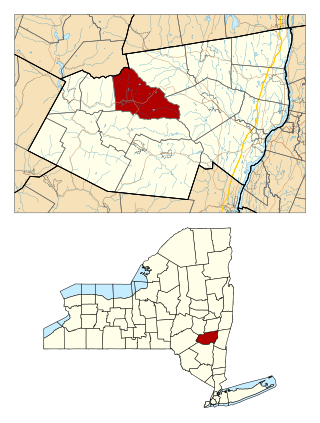
Windham is a town in Greene County, New York, United States. The population was 1,708 at the 2020 census. The town was probably named for the town or county of Windham, Connecticut, as many of its earliest settlers came from that state as well as other parts of New England. The town has two nicknames: "Land in the Sky" and "Gem of the Catskills".

Warsaw is a town in Wyoming County, in the U.S. state of New York. The population was 5,316 at the 2020 census. It is located approximately 37 miles east southeast of Buffalo and approximately 37 miles southwest of Rochester. The town may have been named after Warsaw, Poland.
Pavilion is a hamlet and census-designated place within the town of Pavilion in Genesee County, New York, United States. As of the 2010 census, the population of the CDP was 646, out of a total of 2,495 people in the town as a whole.
























